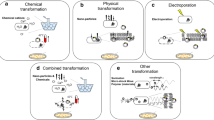Summary
When Neurospora crassa is transformed using a Neurospora gene as the selectable marker, the vegetatively stable transformants obtained cannot be used successfully in a cross because the selectable marker will be inactivated by the process of RIP (repeat-induced point mutation). Introduction of the acetamidase-encoding gene amdS of Aspergillus nidulans into N. crassa by transformation yielded transformants that would grow in minimal medium containing acetamide as a sole nitrogen source. In mitotically stable transformants containing a single copy of the amdS gene, the capacity to utilize acetamide as a sole nitrogen source was maintained in the progeny of a sexual cross. Therefore, the A. nidulans amdS gene is an appropriate dominant selectable marker for use in transformation analyses with N. crassa in which sexual crosses will be subsequently performed.
Similar content being viewed by others
References
Austin B, Hall RM, Tyler BM (1990) Optimized vectors and selection for transformation of Neurospora crassa and Aspergillus nidulans to bleomycin and phleomycin resistance. Gene 93:157–162
Beri RK, Turner G (1987) Transformation of Penicillium chrysogenum using the Aspergillus nidulans amdS gene as a dominant selective marker. Curr Genet 11:639–641
Case ME, Schweizer M, Kushner SR, Giles NH (1979) Efficient transformation of Neurospora crassa by utilizing hybrid plasmid DNA. Proc Natl Acad Sci USA 76:5259–5263
Davis RH, de Serres FJ (1970) Genetic and microbial research techniques for Neurospora crassa. Methods Enzymol 17A:47–143
Debets AJM, Swart K, Holub EF, Goosen T, Bos CJ (1990) Genetic analysis of amdS transformants of Aspergillus niger and their use in chromosome mapping. Mol Gen Genet 222:284–290
Faugeron G, Rhounim L, Rossignol J-L (1990) How does the cell count the number of ectopic copies of a gene in the premeiotic inactivation process acting in Ascobolus immersus? Genetics 124:585–591
Foss EJ, Garrett PW, Kinsey JA, Selker EU (1991) Specificity of repeat-induced point mutation (RIP) in Neurospora: sensitivity of non-Neurospora sequences, a natural diverged tandem duplication, and unique DNA adjacent to a duplicated region. Genetics 127:711–717
Hynes MJ (1978) Multiple independent control mechanisms affecting the acetamidase of Aspergillus nidulans. Mol Gen Genet 161:59–65
Hynes MJ, Pateman JAJ (1970) The genetic analysis of regulation of amidase synthesis in Aspergillus nidulans. II. Mutants resistant to fluoroacetamide. Mol Gen Genet 108:107–116
Hynes MJ, Corrick CM, King JA (1983) Isolation of genomic clones containing the amdS gene of Aspergillus nidulans and their use in the analysis of structural and regulatory mutations. Mol Cell Biol 3:1430–1439
Kelly JM, Hynes M (1985) Transformation of Aspergillus niger by the amdS gene of Aspergillus nidulans. EMBO J 4:475–479
Lee SB, Milgroom MG, Taylor JW (1988) A rapid, high yield mini-prep method for isolation of total genomic DNA from fungi. Fungal Genet Newsl 35:23–24
Orbach MJ, Porro EB, Yanofsky C (1986) Cloning and characterization of the gene for β-tubulin from a benomyl-resistant mutant of Neurospora crassa and its use as a dominant selectable marker. Mol Cell Biol 6:2452–2461
Pe'er S, Barak Z, Yarden O, Chet I (1991) Stability of Trichoderma harzianum amdS transformants in soil and rhizosphere. Soil Biol Biochem 23:1043–1046
Penttilä M, Nevalainen H, Rättö M, Salminen E, Knowles J (1987) A versatile transformation system for the cellulolytic filamentous fungus Trichoderma reesei. Gene 61:155–164
Perkins DD (1986) Hints and precautions for the care, feeding and breeding of Neurospora. Fungal Genet Newsl 33:34–41
Rodriguez RJ, Yoder OC (1987) Selectable genes for transformation of the fungal plant pathogen Glomerella cingulata f. sp. phaseoli (Colletotrichum lindemuthianum). Gene 54:73–81
Sambrook J, Fritsch EF, Maniatis T (1989) Molecular cloning: a laboratory manual. 2nd edn. Cold Spring Harbor Laboratory Press, Cold Spring Harbor New York
Selker EU, Cambareri EB, Jensen BC, Haack KR (1987) Rearrangement of duplicated DNA in specialized cells of Neurospora. Cell 51:741–752
Staben C, Jensen B, Singer M, Pollock J, Schechtman M, Kinsey J, Selker E (1989) Use of a bacterial hygromycin B resistance gene as a dominant selectable marker in Neurospora crassa transformation. Fungal Genet Newsl 36:79–81
Turgeon BG, Garber RC, Yoder OC (1985) Transformation of the fungal maize pathogen Cochliobolus heterostrophus using the Aspergillus nidulans amdS gene. Mol Gen Genet 201:450–453
Vollmer SJ, Yanofsky C (1986) Efficient cloning of genes of Neurospora crassa. Proc Natl Acad Sci USA 83:4869–4873
Author information
Authors and Affiliations
Additional information
Communicated by C.A.M.J.J. van den Hondel
Rights and permissions
About this article
Cite this article
Yamashiro, C.T., Yarden, O. & Yanofsky, C. A dominant selectable marker that is meiotically stable in Neurospora crassa: the amdS gene of Aspergillus nidulans . Molec. Gen. Genet. 236, 121–124 (1992). https://doi.org/10.1007/BF00279650
Issue Date:
DOI: https://doi.org/10.1007/BF00279650




